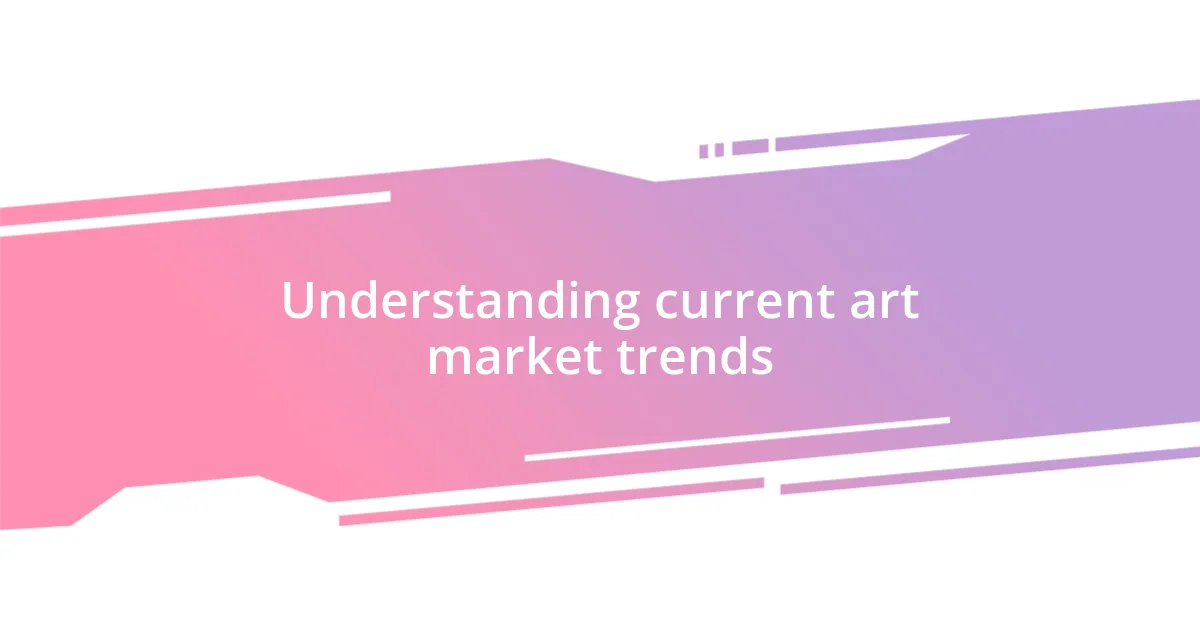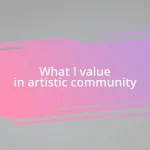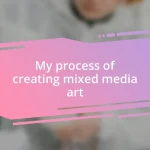Key takeaways:
- The art market is increasingly shifting to digital and online platforms, enhancing accessibility and expanding artist reach.
- There is a growing focus on diversity, sustainability, and the storytelling aspect of art, with collectors seeking authentic experiences over established names.
- Future trends suggest a deeper integration of technology, such as augmented reality and eco-friendly practices, coupled with art’s role in addressing social issues.

Understanding current art market trends
The current art market is marked by a noticeable shift towards digital and online platforms. I’ve been amazed at how quickly galleries and artists adapted during the pandemic, with many turning to virtual exhibitions and online sales. This drastic change got me wondering: how much of our relationship with art can thrive in a digital space?
Another key trend is the growing interest in diverse and underrepresented artists. I remember attending a local gallery opening where the excitement was palpable as visitors discovered new voices that had long been overlooked. It made me realize that people are craving authenticity and stories behind the art, rather than just seeking out established names. Could this shift lead to a broader understanding of art as a reflection of our shared experiences?
Moreover, sustainability is becoming a crucial focus for collectors and creators alike. Recently, I spoke with an artist who exclusively uses recycled materials, and their passion for environmental responsibility was infectious. As more collectors seek to support eco-friendly practices, I wonder if we’re witnessing the birth of a new cultural movement that intertwines art with sustainability, ultimately reshaping our approach to what art means in today’s world.

Key factors influencing art prices
When I reflect on the key factors influencing art prices, it’s clear that the artist’s reputation plays a critical role. I still remember a recent art fair where a relatively unknown artist’s work sold for a fraction of what a well-established name fetched. This disparity highlights how perceived value, built over years of exhibitions and critical recognition, can heavily dictate market prices, often leaving emerging talents at a disadvantage despite their creativity.
Several other aspects also shape art pricing, including:
- Provenance: The artwork’s ownership history can significantly boost its value.
- Market Demand: The popularity of specific styles or themes can create a ripple effect, driving prices up.
- Quality and Craftsmanship: The materials used and the skill demonstrated can set a baseline for pricing.
- Cultural Trends: Trends influencing broader society often reflect in art, impacting what collectors desire at any given moment.
- Economic Factors: A collector’s financial situation can lead to fluctuating investments in art, even for collectible pieces.
I remember a conversation with a dealer who emphasized the role of current events in shaping artistic trends, underscoring how art often serves as a mirror to society’s changing dynamics. This interconnection makes the art market a fascinating, albeit complex landscape.

Impact of digital art sales
The impact of digital art sales has been a game changer in the art world. Personally, I was taken aback by how much of an artist’s reach could expand through online platforms. I remember discovering a talented digital creator whose vibrant works caught my eye on a social media feed. The ability to purchase the artwork directly from their profile allowed me to feel more connected to the artist, almost like sharing a moment with them.
Moreover, the rise of NFTs (non-fungible tokens) has introduced a new layer to collecting. I was initially skeptical about the idea of owning a digital piece in a world full of screenshots, but attending a virtual auction transformed my perspective. It was fascinating to see how digital ownership is revolutionizing not just the way we think about art, but also who can become a collector.
It’s also worth noting that accessibility has increased dramatically. For instance, I recall speaking with a diverse group of budding artists who felt empowered by the digital format. They shared stories of how online platforms allowed them to showcase their work to a global audience that would have been otherwise inaccessible.
| Aspect | Impact |
|---|---|
| Artist Reach | Expanded through social media and online galleries. |
| NFTs | Revolutionized ownership and value perception of digital art. |
| Accessibility | Allowed diverse artists to showcase their work globally. |

Investment strategies for art collectors
When it comes to investment strategies for art collectors, diversification is key. I’ve learned from experience that having a varied collection can buffer against market fluctuations. For instance, while I adore contemporary art, I also invest in classic pieces, recognizing that different genres can respond distinctively to economic shifts.
I’ve often pondered the importance of researching emerging artists. Isn’t it thrilling to discover a new talent before they explode in popularity? I remember purchasing a piece from an artist at a local gallery whose style resonated with me. Fast forward a few years, and their works have seen a significant boost in value, validating my intuition and making the investment all the more rewarding.
Finally, emotional connection plays a pivotal role in my collecting approach. I believe investing in art should also be about passion, not just financial gain. Choosing pieces that resonate with me personally has always enhanced my enjoyment and added depth to my collection. Isn’t that what art is all about? When I look at a piece I love, I not only see my investment; I see my journey as a collector and the stories behind each work.

Future predictions for art trends
As I look into the future of art trends, I can’t shake the feeling that sustainable art practices will gain significant traction. I recall a compelling exhibition that focused on eco-friendly materials and innovative methods that resonated deeply with me. Isn’t it inspiring to see creativity and environmental consciousness intertwine? This growing passion for sustainability can transform not just the artistry but also how we, as collectors, support and choose works.
Another trend I foresee is the integration of augmented reality (AR) in art experiences. Imagine walking into your living room and being able to visualize a painting on your wall through your smartphone before purchasing it. I remember experiencing AR art for the first time at a exhibiting venue, and the sense of wonder it brought was unmatched. This technology not only enhances engagement but also helps collectors make more informed decisions. Can you envision the potential storytelling possibilities through this immersive interaction?
Finally, I believe that art will become even more intertwined with social issues. Artists today are using their platforms to comment on pressing societal matters, and I can’t help but feel the urgency behind these expressions. Recently, I stumbled upon a thought-provoking piece that addressed climate change, and it struck a chord within me. How powerful is it that art can provoke conversations and inspire action? As we move forward, I’m convinced that art will continue to serve as a catalyst for change, making the connection between creativity and advocacy more vital than ever.












